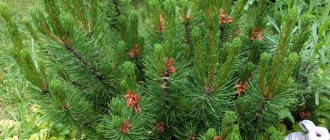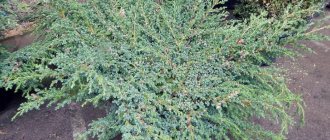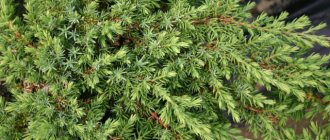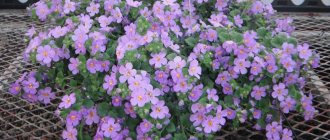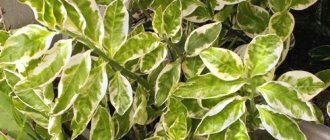General information
Dodecatheon belongs to the genus Primroses. Due to its unusual shape and drooping inflorescences, dodecatheon is also called a meteorite, since in appearance the flowers really look like a celestial body.
In the wild, there are about thirty varieties of the plant. North America is considered to be the birthplace of the goose color. In our country, dodecatheon, even despite its beauty and unpretentiousness, has not yet found widespread use among gardeners.
However, it is being popularized by landscape designers who use it as an unusual and exotic decoration for garden flower beds and alpine slides.
Application in landscape design
Dodecatheon is a peculiar plant that always attracts attention. It is often placed in single plantings, forming a flower bed of several plants of the same or different species. The flower can also be used in compositions. Some interesting ideas with photos:
- Dodecatheon on a rocky flowerbed.
- Decoration in the recreation area next to the gazebo and bench.
- Planting against the background of a lawn.
- Decorating a nondescript place in the garden.
- Planting option against a background of stones.
Advice! The flower goes well with Iberis, astilbe, primrose, wormwood and alpine aster. Looks great in hedges and on the banks of water bodies.
Varieties and types
Dodecatheon Red Wings - the plant has short vegetative shoots and a tall peduncle, the length of which ranges from 10 to 20 centimeters. On each peduncle there are purple inflorescences that look like small meteorites, collected in some kind of brushes. The leaf blades are oval in shape, light green in color and glossy with pronounced veins. The plant blooms in mid-spring.
Dodecatheon Aphrodite is an early flowering plant with a bright, lilac color. The base of the inflorescences is surrounded by yellow stamens. The flower petals are bent back, reminiscent of a falling meteorite. The goose-colored peduncle reaches a height of up to 45 centimeters. The leaves of the flower are medium in size, oval in shape and light green in color. The flowering time of the plant is in the month of May.
Dodecatheon Common - the height of the goose flower reaches up to 50 centimeters. The leaf blades are of medium length, ovoid in shape and have a dark green hue with barely noticeable veining. On one peduncle, from 15 to 20 inflorescences of white, violet or purple hue can bloom. The flowering time of dodecatheon occurs at the beginning of spring.
Dodecatheon Medium - This type of plant is widespread in North America. In nature, it grows on mountain slopes and forest edges. It has wide, long, oval green leaf blades and tall peduncles reaching a length of up to 50 centimeters.
The inflorescences are umbrella-shaped and yellow, white or purple in color. Gooseberry blooms throughout July. This variety is also represented by low-growing plants, reaching a height of up to 20 centimeters.
The dodecatheon is beautiful - the goose-colored variety of this variety reaches from 20 to 50 centimeters in height. It has large, wavy pale-green leaf blades with glossiness and pronounced venation. The inflorescences have a pink or purple tint. The plant blooms in early summer.
Dodecatheon Virginsky
The plant reaches a height of 20 to 50 centimeters. From 15 to 20 umbrella-shaped inflorescences of white or white-pink shade bloom on the peduncle. The leaf blades are large, glossy dark green. The flowering time of the goose blossom is at the end of spring - beginning of summer.
Dodecatheon Maliflora - the name of this variety speaks for itself. On a peduncle reaching a height of 20 to 50 centimeters, there are not 15 to 20 inflorescences, but only 8 to 10. They have an umbrella shape and a lilac-pink hue. The leaf blades of dodecatheon are oval in shape, glossy, veined and have a rich green tint. The plant blooms from May to June.
Dodecatheon Rooted - the plant reaches a height of 20 to 40 centimeters. Umbrella inflorescences of white or purple hue bloom on thin multiple peduncles. The leaf blades are oval in shape, glossy and bright green in color. The flowering time of dodecatheon occurs at the end of spring and lasts until the end of June.
Dodecatheon Geoffrey - This goose-colored variety is named after the Scottish gardener who discovered this unusual plant. The height of dodecatheon peduncles ranges from 10 to 13 centimeters. Inflorescences with pinkish-purple hue of leaf blades bent upwards bloom on multiple shoots. The leaf blades densely surrounding the peduncles are oval in shape, glossy and rich green in color. The plant blooms in late spring.
Dodecatheon Queen Victoria - the peduncle of the plant reaches a height of up to 30 centimeters. Each stem bears 10 to 12 umbellate inflorescences of a purplish-pink hue. The leaves are long, oval-shaped and dark green in color. Gooseberry blooms from May to June.
Brief description of the plant
The perennial herbaceous plant has a fibrous root system with many strong shoots. Several green leaves form a beautiful rosette and grow to 25-30 cm in diameter. The leaves are quite wide, reaching up to 6 cm and long - up to 30 cm, pointed at the ends.
The stems grow straight and can be up to 30 cm in length, at their tops there are paniculate or umbellate inflorescences, which consist of drooping flowers of white, pink or lilac color.
Each specimen consists of five petals and does not exceed 3 cm in diameter. One inflorescence can contain up to ten flowers, which radiate in a circle from the center on short stalks. Between the stamens and petals there are circular anthers, usually colored yellow . Flowering lasts almost the entire summer period, and by the end of summer the green part of the plant completely dies off. The fruit is a capsule containing a mass of small seeds.
Dodecatheon planting and care in open ground
Since dodecatheon is an unpretentious plant, it can take root in any soil. For growing, you should choose a place with weak partial shade, without bright sun and direct sunlight on the flower. The plant is resistant to temperature changes and frost-resistant, so it tolerates both dry summers and cold winters equally well. But in order for the plant to maintain its decorative appearance, it is still not worth subjecting it to tests.
Young plants should be planted in open ground either in early spring or late autumn. Before planting, the soil in the selected area must be loosened and fertilized. Then dig holes the size of the plant roots and fill the bottom with fine expanded clay for drainage.
Carefully lower dodecatheon into each pre-moistened hole and straighten the root system. Next, the planted plants are covered with soil, making sure that there are no voids left underground. After planting, the goose flower should be watered generously and mulched with humus. It will take about a month for rooting, after which the dodecatheon can be considered established.
Loosestrife is also a member of the Primrose family. It is grown by planting and caring in open ground without much hassle, subject to the rules of agricultural technology. You can find all the necessary recommendations in this article.
Reproduction methods
Different types and varieties of dodecatheon can be propagated:
- Dividing the bush.
- Seeds.
The first method is the simplest. To do this, choose an adult dodecatheon bush (3–4 years or older), dig it up at the end of October or at the beginning of April. Divide into several parts so that each of them has several healthy shoots and roots. Replant to a new location, water and mulch.
Growing dodecatheon from seeds is also quite simple. They can be planted directly in open ground or in a seedling container.
In favorable conditions, the plant reproduces by self-sowing. Therefore, if the fruits and seeds are not removed in time, the flower may take over excess space, crowding out neighboring plants.
Transplanting dodecatheon
Transplanting dodecatheon should only be done when the plant is dormant. If you carry it out during the vegetative period, the plant will take a very long time to adapt and will stop blooming.
Transplantation must be carried out in early spring or autumn. The procedure is performed as follows. First, the soil in the planting area is dug up and mixed with humus. Then they dig planting holes, make a drainage layer of expanded clay and water each of them.
After this, a plant is placed in each hole and the root system is straightened. At the end, the holes are filled with soil, pressed lightly, watered and mulched with straw or rotted humus.
Dodecatheon fertilizer
The plant should be fertilized in spring and autumn by adding rotted organic matter or peat under the bushes. Thus, you can not only feed the goose flower, but also mulch it.
If you use mineral fertilizer, then preference should be given to a mixture for flowering plants. It must be diluted with water, which is used for irrigation during the flowering of dodecatheon.
Usage
Dodecatheons are good in group plantings near borders, along hedges or in rock gardens. These moisture-loving plants are suitable for edging small ponds. Goes well with low-growing conifers or ferns.
Drakvennik is good because it pleases with flowering one of the first, when other plants are just gaining strength. But it also fades early, and by August even the leaves fall off. To prevent bald spots from appearing in the flowerbed, it is necessary to combine the plant with green ground cover specimens. Good neighbors for dodecatheon will be European hoofweed, hosta, heuchera, quarry or aquilegia.
Dodecatheon flowering
The flowering time of goose blossoms is at the end of spring - beginning of summer. It lasts about forty days. The inflorescences of the plant can have various shades from purple and pink to snow-white.
After flowering, a seed box with small seeds is formed. In August, the growing season ends and the above-ground part of the dodecatheon begins to die off.
Features and morphological description of dodecatheon
Dodecatheon is a herbaceous plant for open ground, which belongs to the large Primrose family and has 15 species and 23 subspecies, which are very popular among gardeners around the world. It is impossible to grow all varieties on the territory of Russia due to a different climate, but you can still plant the brightest varieties on your site and enjoy the bright primrose every spring. The dodecatheon flower is a perennial, herbaceous, rhizomatous plant that closely resembles the flowering cyclamen or miniature primrose.
This unique and very delicate plant has many names, which are assigned to dodecatheon due to its complex scientific name. It consists of two Greek words, which when translated mean “plant of the twelve gods.” This name may be due to the fact that this plant was often used for medicinal purposes in ancient times. Sometimes you can find another explanation for this name: it is believed that this is the number of flowers on long peduncles that appear in these plants. Due to the great similarity of the colors of dodecatheon with cyclamen, it is popularly called “dreaky”, since cyclamen is sometimes called “dryakna”. There is another name for this herbaceous perennial - chandelier, which was given to the plant for the arrangement of flowers on the stem as in the church candlestick of the same name. The simplest popular name for dodecatheon is the nickname “crow's feet”.
The natural habitat of this amazing plant is considered to be the territory of North America, the Pacific coast, Chukotka and Kamchatka. In the wild, dodecatheon can grow in mountainous areas, prairies, and on steep river banks. In the nature of Russia, this flower is extremely rare, and cultivated varieties are also not often found in gardens. However, despite this, the popularity of crow's feet is constantly increasing.
Description of dodecatheon:
- Dodecatheon is a perennial herbaceous plant, which, unlike cyclamen, is a rhizome crop, while cyclamen is considered a tuberous plant.
- This plant can be called an ephemeral perennial, in which the above-ground part dies off some time after the end of flowering, but the root system continues to live.
- The rhizome is very powerful, thick and fleshy, consisting of a large number of thin and short roots.
- One of the main decorations of the dodecatheon is the basal rosette of leaves, which can reach approximately 20-30 cm in diameter.
- A rosette is formed with beautiful and large leaves, the length of which can be on average 30 cm and the width 6-7 cm. The leaf plate is oblong, wide in the central part, oval in shape, which tapers towards the base and apex. The leaves are very soft, bright green.
- Most often, the root rosette consists of 5-8 large leaves, which manage to grow quite quickly in the spring.
- The height of the entire plant can reach from 10 cm to 50 cm, which depends on the specific type and variety of dodecatheon.
- Around the end of May or early June, long peduncles rise above the lush rosette of leaves, which can grow on average 30 cm in height. The stems are bare, without foliage, erect, greenish-brown in color.
- All flower stalks end in beautiful and fragile flowers, which can reach a maximum diameter of 3 cm.
- Dodecatheon flowers form a small umbrella inflorescence at the top of the peduncle.
- The flowers have five petals, they are single, drooping, with a drooping head and petals bent back, which is very reminiscent of cyclamen flowers.
- As the petals open, they move back completely, revealing golden anthers.
- Dodecatheon can bloom with inflorescences of various shades: white, pink, crimson, lilac, yellow, purple.
- In America, dodecatheon flowers are called small meteorites for their resemblance to an accelerating rocket.
- The flowering of this herbaceous perennial begins after all the other primroses have faded, which allows you to admire it for a whole month.
- This is a unique plant that manages to grow foliage from April, produce flower stalks and bloom within a whole month.
- After flowering, the inflorescences with dried flowers remain on the plant until the barrel-shaped seed pod, which contains a large number of small dodecatheon seeds, is completely dry.
- Around mid-August, the above-ground part of the plant begins to die, which can last only a couple of days.
- Dodecatheon is distinguished by its endurance to temperature changes, frost resistance and excellent honey-bearing qualities.
Preparing dodecatheon for winter
After the plant fades and its ground part dies, it begins a period of rest and preparation for wintering. But even at this time, the goose flower should not stop watering, as it stores nutrients for the next season. The best solution would be to mulch the ground with peat or humus.
Although the plant does not need winter shelter, dry leaves or spruce branches can be placed on top of a layer of mulch, which will become additional protection from frost.
Dodecatheon - photo
Dodecatheon is a very unusual and rare plant for our area, which nevertheless can decorate any spring garden or flower garden. This sophisticated perennial does not require much effort to grow; its bright and beautiful flowers will delight you for a month, even with minimal care.
Dodecatheon growing from seeds
Goose blossom can be propagated by seed or by bush division.
Considering that the plant grows well and takes root quickly, many gardeners use the seed method to grow this flower. It is necessary to sow seeds in open ground in mid-April.
The area for sowing is prepared in advance; it is better to do this in the fall so that the soil settles a little. In the spring, when the soil warms up, shallow furrows should be dug at a distance of 20 centimeters from each other. Then mix the seeds with dry sand and sow in prepared areas. Thanks to sand, crops can be made more sparse.
You should take into account the fact that the first shoots with leaves will appear quickly, but they will also die quickly, so there is no need to panic, since the goose blossom will sprout a second time and will be more persistent. It is necessary to water the seedlings three times a week, but the watering should be such that the soil does not become crusty. You can prevent its occurrence by mulching the beds with loose humus after sowing the seeds.
When the seedlings grow to about 7 centimeters, they should be weeded and thinned out so that the distance between them is approximately 5 centimeters. The distance between grown bushes should be at least 10 centimeters so that they can actively grow and develop.
Planting dodecatheon: step-by-step instructions
A dodecatheon in the garden will be an excellent decoration and will delight you with bright and showy flowers in spring. Planting this plant will not be difficult if you follow all the necessary steps correctly.
Stage 1. Selection and acquisition of dodecatheon planting material
- First of all, you need to purchase planting material for this plant. In this case, there are several options. You can buy dodecatheon as seeds and sow it in open ground on your site.
- Some gardeners prefer not to waste time and effort on growing seedlings, so they turn to nurseries where plants are professionally grown and buy ready-made seedlings or cuttings of this plant.
- It is also important to decide on the dodecatheon variety. Not all varieties of the crop can be grown in Russia, so you should give preference to those varieties that thrive in temperate climates, for example, medium dodecatheon or beautiful dodecatheon.
Stage 2. Choosing a place to plant dodecatheon
- At the next stage, it is important to choose a place to plant this plant.
- This plant prefers to grow in soft and diffused light, so it is best to choose a piece of land for planting dodecatheon that is illuminated in the morning or evening.
- The perennial grows well both in a sunny place and in light shade.
- It is important to ensure that the area is slightly protected from strong winds.
- Do not forget to put identification marks at the place where the dodecatheon is planted, since after the upper part dies off it will be difficult to understand where the plant grows.
Stage 3. Selection and preparation of soil for planting dodecatheon
- Dodecatheon is considered an unpretentious plant that can grow well in any soil. The main thing is that the soil is nutritious and fertile, and also allows not only air, but also moisture to pass through well.
- Therefore, before planting this plant in the ground, you need to take care of preparing the soil mixture.
- First of all, you need to carefully dig up the selected area using a fork or shovel, after which the area needs to be loosened and leveled. It is also recommended to apply fertilizer, you can add a little humus.
Stage 4. The process of planting dodecatheon in open ground
- Dodecteon seedlings can be planted in open ground in spring or autumn.
- It is necessary to first prepare planting holes at the selected location. The depth of each hole will depend on the root system of the seedlings, but on average it should not be more than 8-10 cm. If you are planting a group of plants, then be sure to maintain a distance of 10-15 cm between the holes.
- After this, each hole needs to be shed a little with water.
- Next, you need to carefully remove the seedlings from the pots or containers using the transshipment method, while being careful not to damage the root system.
- The seedlings need to be planted at the same level, without deepening the root collar.
- After planting, young plants are watered, and the surface of the earth around them is mulched with humus.
- The first weeks after planting, you need to water the bushes more often.
Dodecatheon propagation by bush division
Bush division is also a simple, affordable and effective way to propagate a plant. The plant should be propagated in this way at the end of September or at the beginning of March. For this purpose, a goose-colored bush is dug up from all sides and a part of the plant with three growth points is carefully removed from the ground, cutting it off with a knife from the mother bush. In this case, even if one kidney dies, the rest remain viable.
The cut off parts of the bush are planted in prepared planting holes, at the bottom of which drainage and several handfuls of humus will be placed, providing the plant with nutrition for several seasons to come.
The root collar should not be buried, leaving the same level of deepening as that of the mother individual. After planting, dodecatheons must be watered and mulched, making the distance between the bushes at least 10 centimeters.
Diseases and pests
Dodecatheon is a very hardy and resistant plant, so diseases and pests, with the exception of a few, do not threaten it. If the goose blossom is not properly cared for, or rather, the watering regime is not followed, excess moisture may begin to stagnate and lead to rotting of the root system , which can lead to the death of the green pet.
The plant can also be attacked by slugs and ants . You can get rid of slugs by collecting them manually or by scattering crushed shells or wood ash on the area with dodecatheon. The only way to save goose flowers from ants is by replanting them in a new place.


